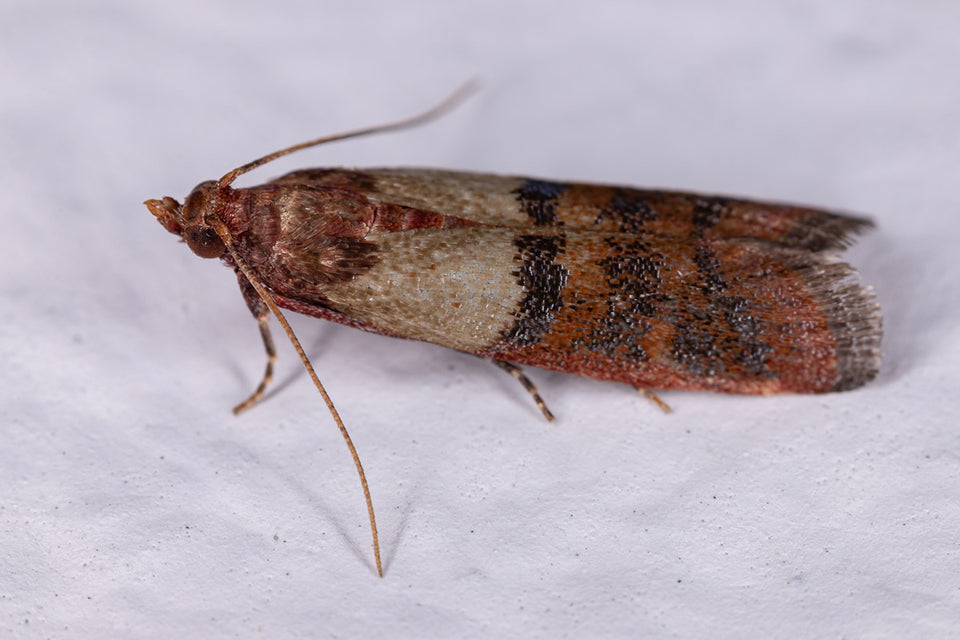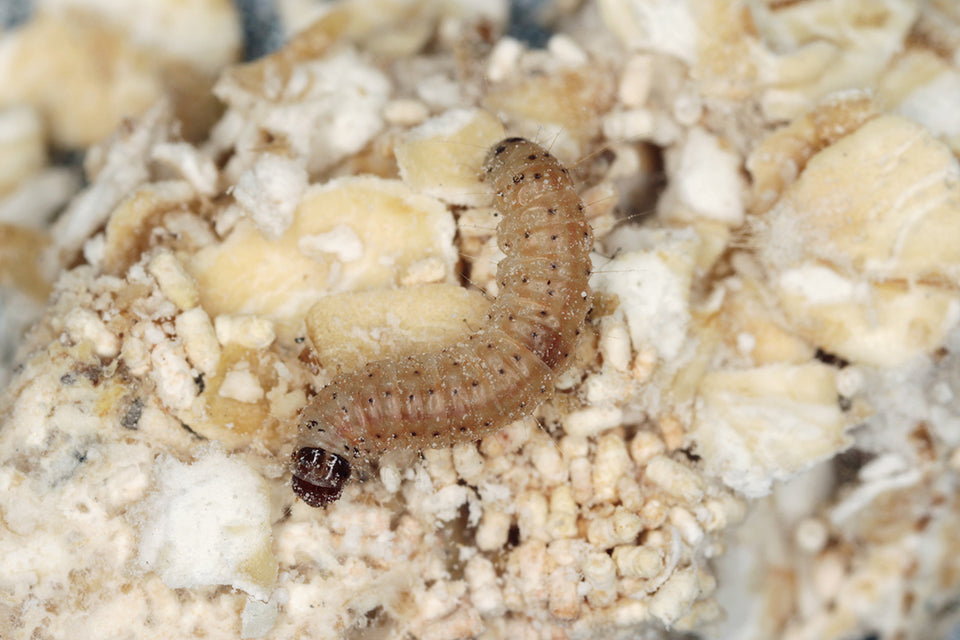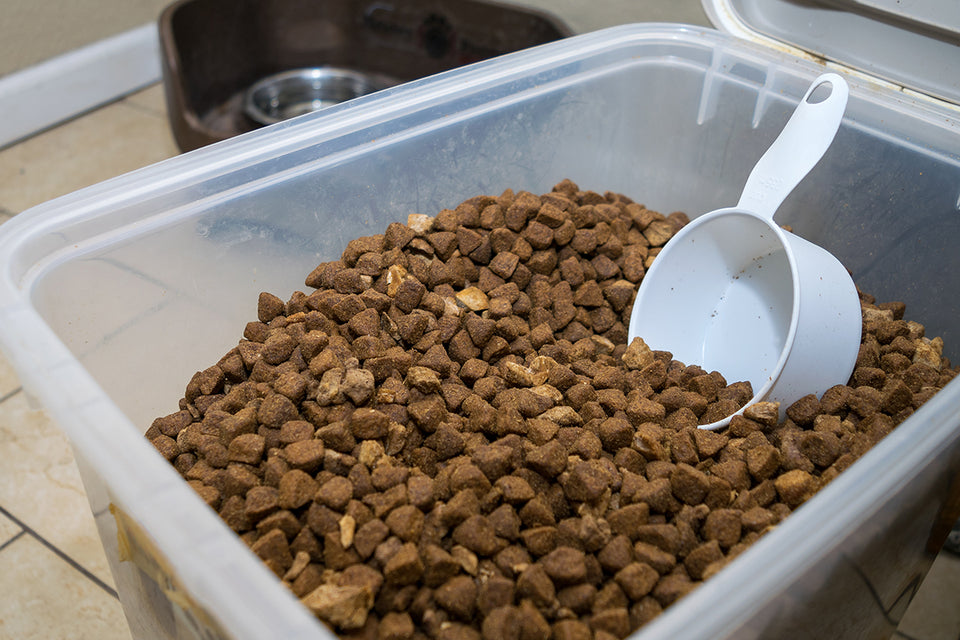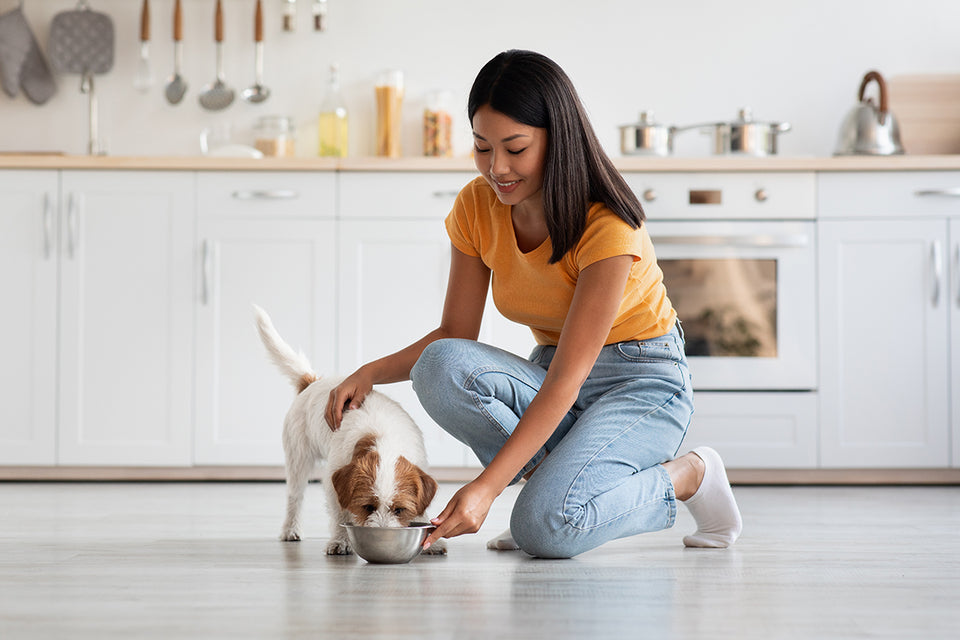Common Bugs In Dog Food - What To Do?

It can be pretty disheartening to open up a bag of Fido’s favorite kibble only to find a bunch of nasty little insects crawling around. Perhaps, your bag of dog food has been open for a while and you are only just now realizing that it has bugs in it. Or, maybe you recently purchased a bag of dog fresh food from the store and upon opening it, you found small little worms crawling around inside. Regardless, it’s not uncommon to find moths and bugs in dog food, and there are plenty of solutions available to you. In this guide, we’ll cover everything you need to know about insects in dry dog food and what you can do to prevent them with effective moth prevention.
How Bugs Get Into Dog Food in the First Place
Moths are commonly attracted to lay their eggs in dry goods like dog food. This is for their Moth Larvae to feed on once they have hatched. Other insects can also acquire nourishment from the ingredients of animal feed. Indian Meal Moths are particularly common in shelf-stable dry goods like pet food. Many people are surprised to learn that Indian Meal Moths, as well as other insects, usually get into pet food at the factory itself. This means that an infestation could be present before you even open the bag! Food boxes and bags can become contaminated in warehouses and storage facilities. Spoilage can also take place as the dog food sits on a shelf in a store or while it is transported.
Another way that insects get into dog food is through openings that you are unaware of. For example, you could simply have a hole in your bag of dog food that allows bugs to make their way inside. If your dog loves to chew on his food bag when you’re not looking, there might even be multiple holes for insects to crawl through. Or, if you are storing your dog food in a shed, your garage, or a barn, it's reasonably easy for pests to find their way inside. Bulk shelf-stable pet food items are often the most susceptible to infestations. This is because they sit out in the open for the longest periods. This is because they sit out in the open for the longest periods, likely without moth prevention moth traps in place to deter infestations.
Most Common Bugs in Dog Food
Finding worms in dog food, maggots in dog food or other bugs in dog food is not a pleasant experience. In many cases, the “worms” you see are the moth larvae of a few common household pantry pests. The most common insects found in dry dog food include Indian Meal Moths, red-legged ham beetles, copper beetles, flour weevils, Sawtooth grain weevils, warehouse beetles, and drugstore beetles. However, cockroaches and other pesky insects will eat dog food when given the chance. Installing pantry moth traps near your pet food storage can help detect and control infestations before they spread.

A List of the Most Common Pests that Infest Pet Foods
- Pantry Moth (Indian Meal Moth)
- Sawtoothed Grain Beetle
- Weevils (Flour Weevils, particularly)
- Drugstore Beetles, Warehouse Beetles, Red Legged Ham Beetles
- Mice, Cockroaches, and Other Scavengers
Why Insects are Attracted to Pet Foods
The simple answer is nutritional value. In the same way that your dog gains nutrition and sustenance from their food, insects can enjoy the same benefits. Pantry Moths are particularly attracted to dog food and other dry food goods because they can safely lay eggs in the crevices of paper or plastic packaging and the food will nourish the moth larvae when they hatch.
These eggs are easy for a female moth to hide in a large bag of dog food, often sticking in the corners. This means that they almost always go undetected until they hatch. As soon as the eggs start hatching, they turn into larvae. Since the food source is readily available right away, these larvae can feed easily on the abundant kibble feast. To prevent this, using pantry moth pheromone traps or moth prevention products is recommended.
The same concept applies to maggots, beetles, and other insects commonly found infesting dog food. An insect lays eggs, the eggs hatch, and little worms start crawling all over the kibble. Other insects like cockroaches can be attracted to dog food in the adult stage. Cockroaches will usually infest dog food after you bring it home, as they scavenge and seek easy meals. So, any dog food bag with an easy-to-access opening can be attractive, and thus, susceptible to spoilage, by scavenging insects. Proper storage and moth prevention in pantries can help reduce risk.
Detecting an Insect Infestation in Kibble: How to Spot Bugs in a Bag of Dog Food
Identifying an insect infestation in a bag of pet food might not be easy. In many cases, bags of dog food become infected at the packaging facility itself. Therefore, you are unlikely to see any actual bugs crawling around at first. Usually, infestations go undetected until the moth larvae become large enough for you to see with the naked eye. In the beginning stages, insect eggs are nearly impossible to detect since they measure just a few hundredths of an inch.
Since in many scenarios, an infestation starts at a dog food packaging establishment, on the store shelves, or even during transit, you could unknowingly bring bugs into your home. Since you don't want to have to dump out your bag of dog food searching for nearly microscopic moth eggs, you won’t usually notice that you have an issue until a few weeks later. Detecting an infestation of insects in a dog food container will almost always involve you seeing the actual moth larvae crawling around. Using pantry moth traps early on can help identify the issue before it spreads.

You can identify larvae by their size and color. Usually, insect larvae will measure anywhere from 1/5 of an inch to 1/2 of an inch long. Moth larvae look like tiny caterpillars. However, most people don't regularly inspect their pet food. This means that you will probably not realize that you have a moth problem on your hands until you see an adult flying around your pantry. At this point, the infestation could spread to the rest of your pantry or home, making moth prevention even more crucial.
If you notice adult moths flying around your pantry and then realize that there are larvae in your dog food, there's a good chance that you already have an all-out infestation on your hands. Some adult female moths can lay up to 400 eggs in just two weeks. As such, detecting and stopping insect infestations in your dog’s food is an incredibly important part of pantry pest prevention. Setting up moth prevention moth traps near the storage area can be a proactive step to stop the spread.
8 Ways to Control or Prevent Moths in Dog Food
Pantry Moths love to infest dry goods like grains and cereals. This can include kibbles, animal feed, and more. Finding Pantry Moths in dog food is never a welcome surprise. To prevent moths and other insects from getting into your dog food supply, there are a few things you can do.
1. Inspect all of your new packages of pet food
First and foremost, you should check all bags of dog food that you bring home from the store for the presence of insect larvae. Checking your bags of dog food right away can prevent all kinds of trouble from occurring later on down the road. While moth eggs can be nearly impossible to detect in dog food, the larva should not be difficult to spot if you know what to look for.
After you first open a bag of dog food, let it settle until it is completely still. This might mean keeping your hungry dogs in another room so that you can focus! Then, when the food is still, look for signs of movement. This can take a little bit of patience. However, moth larvae like to crawl around on the tops of kibbles. You may want to shake the bag of dog food around a little bit and see if you notice anything moving.
Moth Larvae are usually small and brown and can blend in with the kibble. Sometimes, they can also get coated in tiny crumbs, giving them extra camouflage. Keep an eye out for little caterpillar-like insects with a slightly shiny appearance. If you notice moth larvae, it might be time to toss your dog food in the garbage, call the store for a refund, or take steps to safely kill the larvae so an infestation doesn’t spread.
What if you do find larvae when you inspect your dog’s food?
If you can’t return the dog food and aren’t willing to chuck it in the dumpster, freezing it for a few days can solve your problem. You can put your dog food bag in a freezer for 72 hours to kill any larvae. Although this may impact the flavor slightly, most dogs don’t seem to notice the difference! For long-term moth prevention, consider storing food in airtight containers and using pantry moth pheromone traps.
2. Clean up any spills or loose kibbles
Loose kibbles rolling around on the floor or food spills can attract insects and all sorts of other pests into your home. So, if your dog is a messy eater, be sure to sweep up regularly after he is done with his meal. Dog food in large bags can be hard to pour. So, if you spill a lot of dog food when filling up Fido’s bowl, be sure to clean that up as well. Make sure to get any sneaky kibbles that roll under your oven, refrigerator, or near your baseboards. This is especially important for moth prevention in kitchens, where moths can easily find a new food source.
3. Keep all of your pet food in a sealed plastic container or storage tub.

One great way to ensure that your dog food will not become infested with disgusting insect larvae is to store it in an airtight container. Large plastic bins can be perfect for dog food storage. As soon as you bring a bag of dog food home from the store and inspect it for freshness and spoilage, pour it into a large, airtight, clean plastic bin that can be shut with a lid.
Then, tightly seal the lid. Make sure that this lid stays on when you aren't scooping food for your dog to eat. As a bonus, this will help to deter your dog from sneaking snacks between meals or chewing through the corners of your dog food bag. Plus, it looks nicer than a big bag of food in the garage or pantry. This approach also works well with moth proof bags for clothes, for anyone looking to protect other storage areas in the home from moths.
4. Always store dog food properly
It is important to store dog food properly to prevent pests and spoilage. You should store dry dog food in a cool, dry, climate-controlled area. Your pantry can be a good place to store dog food. However, many people prefer not to store their dog’s kibble near their “people food” or canned goods. Some people find the odor of dog food to be unpleasant. If this is the case, you can store dog food on a shelf in the garage or an entryway.
Be sure that the place you keep your dog food is free of moisture and not regularly subjected to extreme temperature fluctuations. Places that get hot for instance, like a garage in the summer, can cause the dog food to become fragrant and may attract pests like pantry moths. Also, choose an area that is cleaned regularly. That way, insects or pests like mice won’t be attracted to that area as easily.
5. Try to rotate your pet food supply regularly and inspect it occasionally
You should consider stirring your dog food or shaking it around regularly. When you are always moving or disturbing your pet’s food, it becomes less attractive to insects. This is because most nesting bugs prefer undisturbed, quiet areas. When you scoop out dog food, shift it around and rotate it. Be sure to keep a keen eye out for larvae or signs of a pantry moth infestation as well.
6. Clean your dog's eating area frequently
Keeping the area where your dog chows down clean and insect-free is also important. Some dogs are notoriously messy eaters. Other dogs aren't necessarily messy eaters but do leave behind lots of little crumbs and teensy food particles that can attract insects. Be sure to sweep, mop, and vacuum anywhere that your dog regularly enjoys his kibble. Also, be sure to regularly clean and wash dog bowls in the dishwasher or sink.
7. Use Moth and Insect Traps or Deterrents
Moth traps can help intercept those pesky winged devils from making your dog food the breeding nursery for their pantry moth larvae. Pheromone pantry moth traps use an "attractant" (that's the pheromone bit) on the sticky strip in order to catch adult male pantry moths. This then helps break the breeding cycle.
There are also a few natural ways to deter insects from creeping around your pantry or dog food storage areas. Herbal moth-deterrent sachets, for instance, can be a solution for preventing bugs in dog food. These sachets can be filled with fragrant and harmless herbs like lavender, thyme, sage, mint, rosemary, cedar, cloves, and the like. This can help you reduce the likelihood of an infestation, especially in a small enclosed area like a pantry, garage, cabinet, or closet.
Be careful not to use "attractant" pantry moth traps in combination and close proximity to your natural "moth deterrents" because the deterrent will disturb the power of the trap pheromones.

8. Regularly monitor your pantry and food storage areas for pests
Finally, stay vigilant. Regularly keeping an eye out for signs of pests can help you catch an infestation right away. The sooner you notice an infestation, the sooner you can start getting rid of it. This can prevent moths and other insect infestations from getting out of hand or spreading throughout your home.
How To Get Rid of Moths in Dog Food: Here’s What to Know
So how to get rid of Pantry Moths in dog food? If you notice that there are moths in your dog food already, particularly, if you spot worm-like moth larvae, you can freeze your dog food in an airtight container or large plastic bag for 72 hours. This will effectively kill any larvae or eggs hiding in the kibbles. Then, you can thaw your dog food back out and feed it to your pets as usual. The presence of dead moth larvae in dog food will not harm your pets, and may even provide them with some extra protein!
Or, you can follow the simple rule: if in doubt, throw it out. Then, if your pet food is within date and was freshly opened, consider calling the store or pet food company and requesting a refund! Although, there are often time limits in which a refund can be requested. So, be sure to always inspect your dog’s food when you first bring it home from the store.
Removing Grain Moths in Dog Food Bags
Getting rid of Indian Meal Moths in dog food usually involves freezing the entire food bag for at least 72 hours. This effectively kills all eggs or larvae hidden in the cracks, crevices, and kibbles. Be sure to seal the dog food in a large airtight container like a big plastic bag or a trash bag before putting it in your freezer. Then, clean any areas where the bag was sitting using a solution of 1 part vinegar to two parts water. That way, any loose larvae or eggs will be eliminated. If you can’t fit all of the dog food in the freezer, you can separate it into smaller plastic bags.
Position Pantry Moth Traps in areas where you are seeing moths or expect moths might be present. The Traps will enable you to monitor for any further moth presence while attracting the active adult male moths and helping to break the breeding cycle. If you have a persistent infestation you may like to read our Pantry Moths Kit Guide which gives you guidance about using non toxic moth killing sprays in line with our Pantry Moth Traps.
FAQs About Moths and Insects in Dog Food
Now that you know all about how moths get into dog food, what to do if you see larvae in dog kibble, and why insects like pet foods, here are the answers to some frequently asked questions on the subject.
Why are there moths in my dog food?
Dog food may become infested with insects for many reasons. If a bag of dog food was sitting unattended in an area exposed to the elements, it is easy for insects to find their way inside. Many bugs and pests are attracted to pet foods due to their nutritional content. It may also be that the dog food became infested with insect eggs at the factory itself.
Are moths harmful to dogs?
No, the good news is that Clothes, Carpet and Pantry Moths are not harmful to dogs at all. So, if your dog has ingested moth larvae or adult moths, it will likely be totally fine. If you are really worried about your dog or if it is behaving strangely, contact your veterinarian for reassurance. The pet food may have expired or become spoiled and your dog could be suffering from digestive upset or some other unrelated issue.
What happens if you eat food with moth larvae?
If you eat moth larvae, you will merely be ingesting a bit of extra protein. However, you are likely to be totally disgusted, as no one wants to consume bugs unknowingly. Generally, if you have consumed food with moth larvae in it, you will be fine. Still, if moth larvae have had time to grow and mature in food, there is a significant chance that the food itself is expired. Keep that in mind, as you might be more likely to get food poisoning from consumables that are out of date.

About MothPrevention
MothPrevention® speak to customers every day about their clothes moth issues - clothes moths are a species that are ever increasing and that can cause significant damage to clothes, carpets and other home textiles.
To date, we’ve helped over 250,000 customers deal with their moth problems. We have developed professional grade solutions including proprietary pheromones and trap design, not available from anybody else in the USA.





